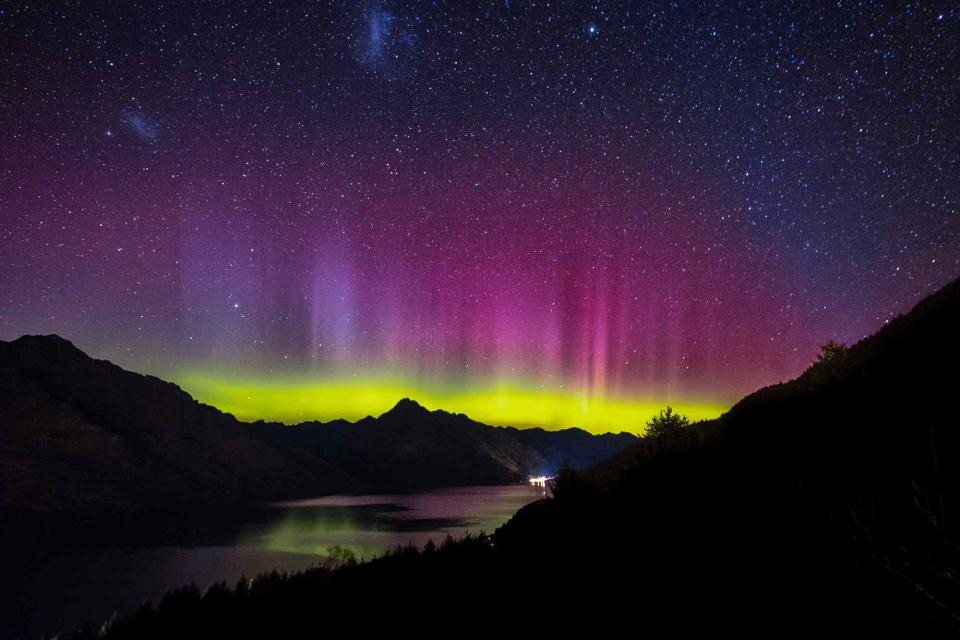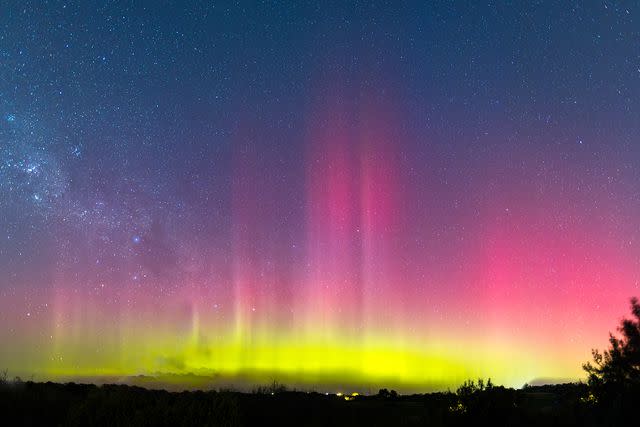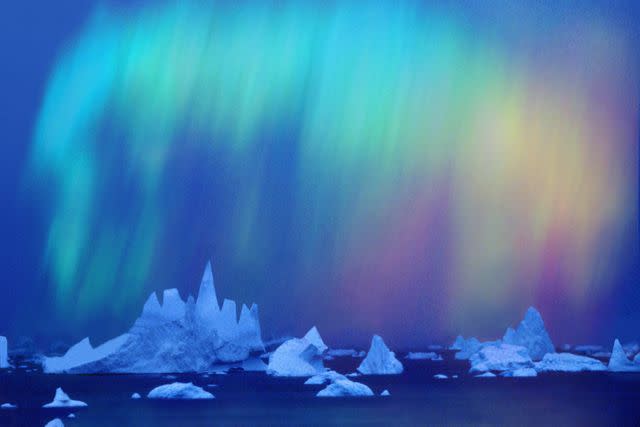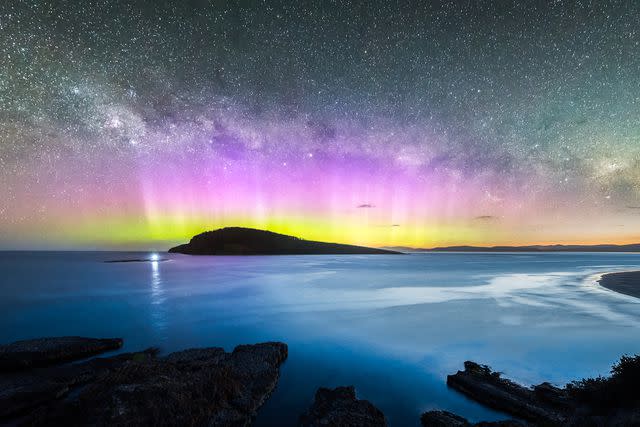The Northern Lights Have a Southern Hemisphere Counterpart That Is Harder to See — What to Know
We've got the answers to all your questions about the aurora australis.

Skyimages/Getty Images
I first glimpsed the northern lights on a red-eye flight across the Atlantic. Just a few pale wisps in the night sky were enough to get me hooked on the celestial phenomenon, and my aurora chasing has since brought me to Greenland, Iceland, and Churchill, Canada. Now, my sights are set on their even more elusive counterpart: the southern lights, or aurora australis.
Here’s everything you need to know about the southern lights, including when and where to see them.
Jonathan Belles is a meteorologist at The Weather Channel and weather.com.
Dr. Jason Steffen is an associate professor of physics at the University of Nevada, Las Vegas.
What are the southern lights?
The southern lights are the Southern Hemisphere’s version of the northern lights — that is, they're both the aurora. "The aurora is a visual representation of the Earth’s magnetic field protecting us from the sun’s disruptive bursts of energy," Jonathan Belles, meteorologist at The Weather Channel and Weather.com, tells Travel + Leisure. When energized particles from the sun slam into the Earth's magnetic field, they're redirected toward the poles, and the particles glow.

Future Publishing/Getty Images
Are the northern lights and southern lights different?
The only major difference between the northern and southern lights is the hemisphere in which they occur. Otherwise, they're the same phenomenon. They even tend to occur in sync. "Usually, both auroras will brighten when there is a lot of solar activity," Dr. Jason Steffen, associate professor of physics at the University of Nevada, Las Vegas, tells T+L. "The particles will be trapped by the magnetic field and will be concentrated simultaneously at both magnetic poles."
But there's always a chance for variation. "They can occur simultaneously when a solar storm occurs, but often their impacts will be asymmetric. In other words, aurora may be more prevalent in one hemisphere versus the other depending on how the burst of energy reaches the Earth and from what direction," says Belles.
When is the best time to see the southern lights?
As with the northern lights, the best time to see the southern lights is whenever the sky is dark. Because the aurora occurs at high latitudes — that is, close to the poles — you may not get much darkness, if any at all, during the summer. So the best time of year to see the southern lights is from roughly March through September, the Southern Hemisphere’s autumn through spring. (The Northern Hemisphere’s aurora season lasts from around September through March.)
On a larger time scale, this year is one of the best years to see the aurora. We’re approaching solar maximum in the solar cycle, which could mean brighter and more frequent auroras. "We’re currently in the most active part of an 11-year solar cycle, when bursts from the sun are most common," says Belles. But that's not to say the southern lights will be no-shows after that — the aurora can (and does) happen frequently, though the light show is often dimmer than the dazzling displays you might be picturing. For the breathtaking dancing ribbons, you might have to wait for strong solar storms. (In case you're wondering, it takes about three days for the sun's aurora-causing emissions to reach the Earth, so you'll have a tiny bit of a heads-up that a good show might be brewing.)

Cavan Images / Per-Andre Hoffmann/Getty Images
How can I increase my chances of seeing the southern lights?
There's one simple thing you can do to increase your chances of seeing the southern lights — spend as much time near the magnetic south pole as possible, particularly during the dark months. (Remember, Southern Hemisphere winter occurs in June, July, and August.) Of course, that's much easier said than done. "It is more difficult to see the southern lights only in that there is less land in the Southern Hemisphere to see it from," says Belles.
Can I see the southern lights on an Antarctica cruise?
It's not likely — I've cruised to Antarctica five times, and I've never seen the southern lights from my ships. There are two main reasons why.
First, the Antarctic cruise season runs through the austral summer, when Antarctica gets up to 24 hours of daylight. If the sky is bright, you won't be able to see the aurora. And second, most cruises visit the Antarctic Peninsula, where the aurora doesn't often appear overhead.
The "auroral oval," or the region of the Earth in which you're most likely to see the aurora, is farther south than most visited parts of the Antarctic Peninsula. "The magnetic field is tilted slightly, so the auroras align with the magnetic poles instead of the geographic poles," says Steffen. And the south magnetic pole is closer to the other side of the continent. So even if you're visiting Antarctica in November or March, when you do get some darkness each night, the southern lights might only appear faintly and far in the distance, not overhead.
Best Places to See the Southern Lights
They’re not easy to spot, but these are three of the best places to see the southern lights.
Related: 10 Best Places to See the Northern Lights Around the World
South Island, New Zealand
The farther south you go in New Zealand, the better your chances of seeing the southern lights. An ideal location would have unobstructed views towards the south, since the southern lights will appear low on the horizon rather than overhead. For your best chances, I'd recommend taking the ferry from Bluff to Stewart Island, which is off the southern tip of the South Island. But it is possible to see the southern lights from popular destinations like Dunedin and Queenstown, too — just make sure you get away from city lights to reduce light pollution.

Chasing Light/James Stone/Getty Images
Tasmania, Australia
Tasmania is another prime destination for southern lights viewing. As in New Zealand, the farther south you go, the better your odds. Some of the most popular viewpoints include Goat Bluff, Carlton Beach, and Tinderbox, all of which are fairly close to Hobart, though far enough from substantial light pollution. You could also try the summit of kunanyi / Mount Wellington, but beware the glare of city lights. For more darkness, you'll want to head to more remote destinations, such as Southwest National Park, the state's largest expanse of wilderness.
Antarctica
I know, I know — I just told you that it's difficult to see the southern lights from an Antarctica cruise. And that's true. But there are some places in Antarctica that do see the southern lights frequently, and the most accessible to travelers is the Ross Sea. Some Antarctica cruises travel to this remote destination, and if you happen to be on one at the right time of year (when the skies get dark at night, from autumn to spring), you might be able to see the southern lights. Alternatively, you could try to get a job at McMurdo Station, the main base of the U.S. Antarctic Program. If you spend the winter there, you're almost guaranteed to see the southern lights.
For more Travel & Leisure news, make sure to sign up for our newsletter!
Read the original article on Travel & Leisure.

